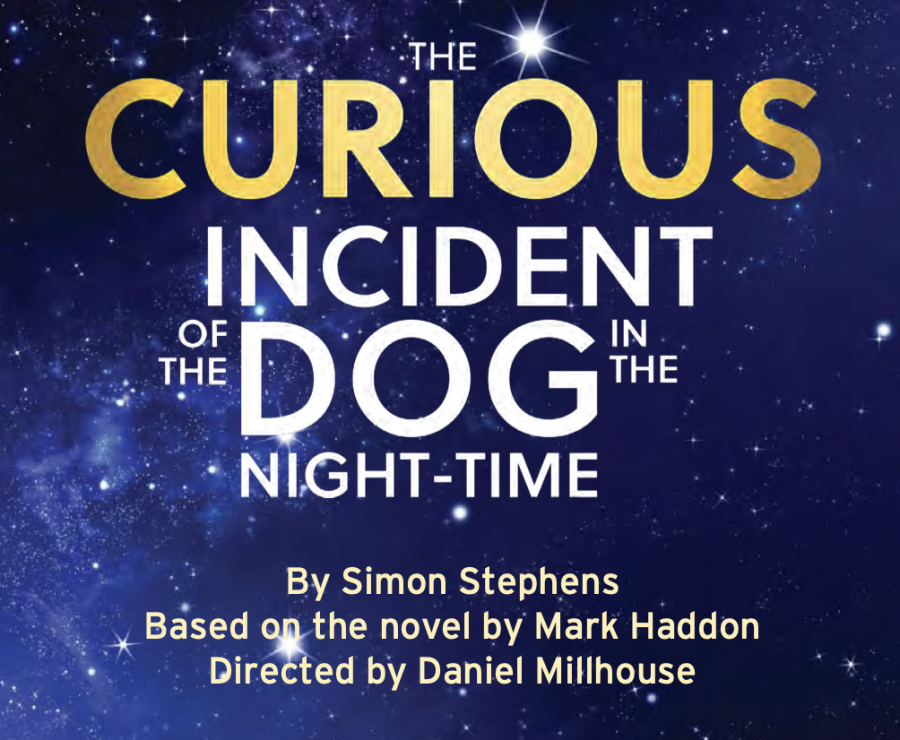The Performance That Redefined a Student Production
From the pages of a novel to the pages of a script, director Daniel Millhouse spearheaded The MAC’s newest play, “The Curious Incident of the Dog in the Nighttime,” to a beautifully fleshed out student performance that left audience members begging for more.
March 20, 2023
The latest play from the MAC at the College of DuPage brings life to an English classic. “The Curious Incident of the Dog in the Night-Time” follows the journey of a boy, Christopher, as he tries to solve the mystery of who killed his neighbor’s dog while dealing with his own troubled family life. In this opportunity, the play was directed by COD Theater Assistant Professor Daniel Millhouse with a lively cast of over 25 students.
As this play was based on the book of the same name, written by Mark Haddon and adapted to the stage by Simon Stephens, actors had source material to work with.
“I read certain passages of the book just to get a general sense of the motives of my character,” explained actor Vinny Scanio, who portrays Ed Boone, Christopher’s father. “I didn’t want to read the entire book because we weren’t performing the book; we’re performing the play, and obviously those two things are not always congruent.
Lilly Zúñiga, who portrays Judy, Christopher’s mother, used a well-known example of being a mom in preparation for her role.
“To prepare for the role of Judy, I found myself looking to my own mother for reference,” Zúñiga said. “One thing I did not want to happen was to lose Judy’s humanity. I think on paper it’s very easy to hate a woman for leaving her family, and I think if I were to only reference the book and script, I would lose a lot of that warmth and compassion.”
One of the notable feats of this edition of the classic play was working with an actual dog, Geordi, a scene-stealer. Geordi is a Lab mix.
Stage manager Rowan Brando said live animals are not a common appearance on the MAC stage.
“Geordi’s owner, Heather, would come to rehearsals, and we would get the dog acquainted with everyone,” Brando said. Especially get him acquainted with Alex, Vinny and Lily (dubbed the dog’s handler by his owner), who are the leads and needed to interact with the dog.”
The performances of the three members of the Boone family: father, Ed (Vinny Scanio); mother, Judy (Lilly Zuñiga), and son, Christopher (Alex Sitman) were captivating. Ed’s stage presence demanded the audience’s attention. When with Christopher, scenes were well established, capitalizing on the myriad of emotions between frustration, sadness and rage that weren’t felt but evoked along the surrounding audience.
“Finding a way to still be you in your interpretation of the character definitely helped a lot,” Scanio said. “Our fight choreographer, Jay Donley, helped with the harder scenes between my character and Christopher and asked us questions about our interactions. (The director), Daniel, made us more comfortable on stage, too.”
When the three were on stage, the human element was present. Audience members were involved in the story because their interaction was brilliantly crafted to touch on whole-hearted family ties.
Zúñiga talked about her complex character.
“I wanted people to see that Judy did love her family. That she cared in the way every mother cares. Dare I say it, I even wanted her to look like a good mom, one that just had to make some bad choices,”
As the play took place in the MAC’s Studio Theatre, the stage was more compact with an alleyway seating style that made the audience feel like a fly on the wall.
Scanio gave his point of view of the unique experience.
“It’s still the same amount of energy, whether you act in a mainstage production where the audience is 500 feet away from you versus a smaller production where the audience can smell your breath. But the tight space does allow a lot more intimacy,”
In a small-scale performance where standards are not always a focus, the movement of the set served a pointed purpose, drawing the audience to concentrate on the details. The fluctuation of the stage mirrored that of a stream of consciousness recollection. The performance itself lived and breathed with its audience, roping it into the story. Though prop-work was minimalistic, it maximized the potential of the story and engaged with the audience’s imagination. Lights and the ensemble helped transform the stage from one scene to another in the blink of an eye.
Zúñiga mentioned the emotional changes were the most difficult part.
“The character of Judy has such intense emotions that are almost always followed by the cut off of a scene change, in some cases even with the lack of a blackout. I’Il be on stage sobbing, then I have to turn and be basking in the sunlight smiling,”
Scanio talked about the cooperative effort in the moving pieces.
“David Makuch, our lighting designer, Fisher Parsons, our sound designer, our stage manager Rowan [Brando] and everybody in the ensemble did a great job. It was good for the audience to understand a quick scene change which also doesn’t just help them but the actors too, to be able to just click and be on a different part,”
Another relevant detail was the decision of not including accents, given that the story is set in and around Swindon and London in the U.K. Both Scanio and Zúñiga agreed the play worked better without this element, as the entire cast would have had to perfect them, and there would be variability between regional accents difficult to perfect. Moreover, it would have affected the impact of the vulnerability in the stronger scenes.
Thankfully, the play successfully achieved an emotional connection with the audience. From the pages of a novel to the pages of a script, Director Daniel Millhouse spearheaded an ensemble cast and production crew to a beautifully fleshed out student performance that left audience members begging for more.




















